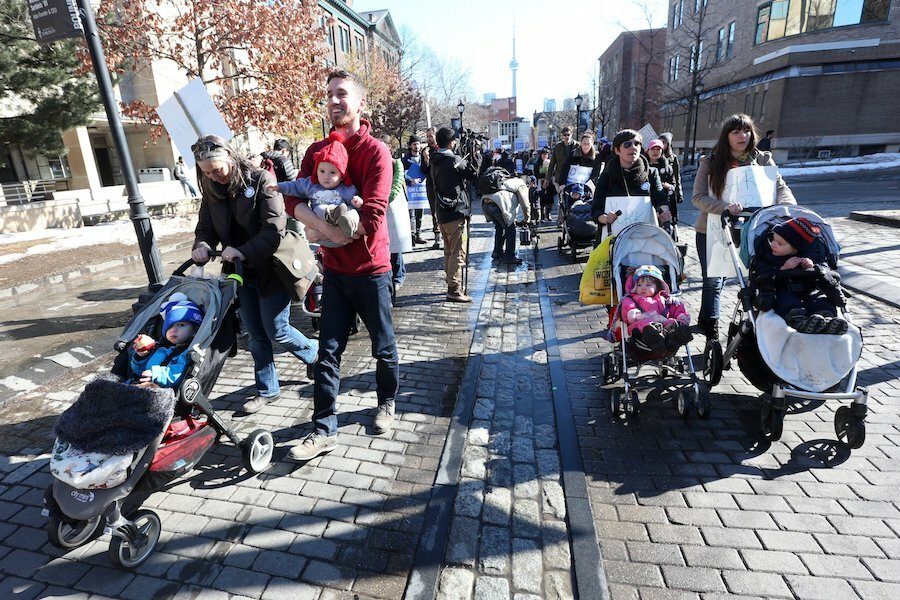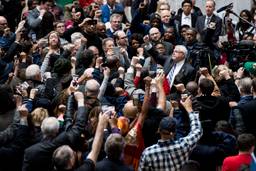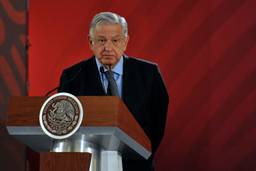
The workers said neoliberal policies had made their jobs more precarious. Ontario’s new right-wing government didn’t care.
Classes are starting at Toronto’s York University after Canada’s longest-ever post-secondary strike came to an abrupt end this summer without a new agreement in place for 2,000 contract teaching and research staff who walked off the job five months ago.
The newly-elected right-wing government in the province of Ontario passed back-to-work legislation at the end July that forced the employees whose collective agreement expired last August to pack up the picket lines and return to work.
While many undergraduate students are relieved to get their academic schedules back on track, union members are left in a lurch as the concerns that prompted the strike remain unaddressed.
Demands for better graduate funding, job security and workplace accessibility in the workplace were central to the strike. The union also raised alarm over increasingly precarious employment for contract teachers and researchers, one symptom of universities doubling down on a neoliberal business model.
Devin Lefebvre, chairperson of the CUPE 3903 union that represents 3,000 teaching assistants, contract faculty, and graduate and research assistants at York University, slammed the back-to-work legislation as an affront to workers’ rights.
“Legislating workers back to work rides roughshod over our collective bargaining rights as well as our right to strike. And in this instance it’s rewarding an employer for bad behavior,” he told In These Times, stressing that York repeatedly refused to bargain.
The back-to-work legislation forces a binding mediation process in which a third party will impose a new collective agreement to settle the dispute.
“This is a way for [the university] to avoid actually negotiating an agreement,” Lefebvre, a PhD student and teaching assistant, argued. “It has already put a chill on labor relations.”
York did not respond to questions from In These Times. In a statement in response to the back-to-work order, the university’s President and Vice-Chancellor Rhonda Lenton described the five months of the strike as “challenging” and welcomed the legislation “after the efforts by both parties were unable to lead to a negotiated settlement.”
Mimi Salami, a fourth-year health studies student from Nigeria, said the strike was “annoying” and “disappointing.” She blamed both sides for dragging out the dispute at students’ expense.
“Students are really struggling,” she said. As an international student, Salami pays tuition fees more than three times more expensive than those of her domestic peers. “The main priority should be the students.”
Karmah Dudin, a fourth-year political science student, sympathized with students frustrated by the strike, but argued that winning favorable conditions for educators would be in students’ best interests. She was active in the student movement called Reclaim YorkU that occupied York’s Senate Chambers in solidarity with CUPE 3903 for nearly three months, redubbing the room the “Student Chambers” to pressure the university to cancel classes and refund students’ tuition. Neither demand was met.
“We felt that the democratic process was being violated,” Dudin said, arguing the root problem lies in university governance.
Some 1,000 contract faculty members making up one of the three CUPE 3903 bargaining units that went on strike on March 5 already voted in June to accept an offer from the university and return to work.
The remaining 2,000 workers now wait for the mediation process to determine their contract. Lefebvre argued that forced arbitration undermines union power and deprives workers of a chance to shape their own working conditions.
Ontario’s Progressive Conservatives, a center-right party pushed further right under its current leadership, convened a rare summer session to pass the omnibus bill containing the back-to-work legislation. An earlier attempt to pass back-to-work legislation under the Liberal government had failed.
The Progressive Conservatives won a majority government in Ontario in June for the first time in 15 years, led by Premier Doug Ford, brother of the late former mayor of Toronto, Rob Ford, who gained international notoriety for a crack cocaine-smoking scandal. The new provincial government’s urgency to quash the CUPE 3903 strike sets the tone as Ontario settles in for four years under the politician who has been described as Canada’s Donald Trump.
“Getting the two parties — the university and the two bargaining units of CUPE 3903 — back to the bargaining table was a top priority…to allow students to complete their classes and ensure that the fall semester isn’t disrupted,” the Office of the Minister of Labour said in an emailed statement to In These Times. “The Back to Class Act was not about the union, it was not about the university, it was about the more than 45,000 students.”
CUPE 3903 members carry out 60 percent of all teaching at York.
“Escalation in Hostility”
York administration, many media reports, and an inquiry into labor relations ordered by the provincial Minister of Labour in April framed the situation as an “impasse” between the university and the union. CUPE 3903 disagreed.
“The employer time and again refused to bargain,” Lefebvre said, accusing York of resorting to “more and more aggressive forms of negotiation,” including intimidation tactics such as hiring a private security contractor and filming union members on the picket lines. Meanwhile, York accused the union of intimidating university officials.
Student activist Dudin said the university also “demonized” the Reclaim YorkU movement and targeted the occupation with an intimidation campaign, including video surveillance.
Lindsay Harding, a doctoral student and teaching assistant in linguistics who served as a picket coordinator, noted an “escalation in hostility” compared to the last CUPE 3903 strike in 2015, which lasted nearly one month. This time, Harding witnessed two hit and run incidents, saw a picketer get punched, and dealt with “people questioning the legality of the strike.” She suspected the “level of aggression” was fueled at least in part by the university’s public relations campaign.
Maija Duncan, CUPE 3903 communications officer, accused the university of waging a “smear campaign” against educators and paying more attention to controlling the narrative in the media than sitting down to bargain.
“It was an attempt to make us bargain with ourselves,” said Duncan, who is also a PhD student and teaching assistant. “What they were looking for was full capitulation.”
In June, York accused CUPE 3903 of not giving the union membership an opportunity to consider the university’s offers and declared arbitration “inevitable.”
Working and Striking in the Neoliberal University
The strike joins a stream of education sector strikes across the United States this year — including statewide teacher strikes in Arizona, Oklahoma, and West Virginia and parts of Colorado — and the historic higher education strike in the United Kingdom.
York has been prone to strikes for decades. CUPE 3903’s willingness to strike has been credited for ensuring contract academic staff at York have enjoyed better contracts compared to their peers at other Canadian universities.
Ongoing discontent stems in part from the deepening of what researchers call the “neoliberal university,” characterized by expanded managerial and administrative staff, a focus on quantitative academic results, higher tuition fees, and growing reliance on a precarious teaching workforce.
According to Alessandro Delfanti, assistant professor of new media and culture at the University of Toronto, a key consequence of universities’ neoliberal turn is growing inequality in working conditions.
“Precarious staff allows a university to save money, is more flexible, and can be disposed of in case for example of drops in enrollment rates,” he wrote in an email to In These Times, adding that precarious employment can be highly stressful. “It is both a political and financial issue.”
Many media reports depicted the strike as a battle for higher wages, but the call for wages to keep pace with inflation was a small issue compared to the union’s top demands for protection of graduate student funding, job security for contract faculty, equity and accessibility in the workplace, and restoring the more than 800 jobs that had been cut from one of the union’s four bargaining units.
“Business as Usual”
Unlike the during CUPE 3903’s 2015 strike, this time York refused to cancel classes. For student activist Dudin, the move was as an attempt to maintain an image of “business as usual” on campus. The result for students was highly confusing, as some faculty chose to suspend classes anyway, while many students were not well informed of their right to refuse to cross picket lines without penalty, said Dudin.
Courses taught by striking educators, put on hold about two thirds of the way through the semester, remained in limbo for months. York did not reimburse students for the classes disrupted by the strike, but instead offered students an “assessed grade” based on 70 percent completion of coursework or an opportunity to take the course a second time free of charge. Other courses were finalized in a remediation period in July and August after the government legislated the union back to work. Students also had an option to defer completion of coursework until December.
All of this created confusion for both students and educators.
Salami, the health studies student from Nigeria, said retaking courses was not an acceptable option — she still hopes to graduate on schedule while working a part time job at least 20 hours per week — and opted for the assessed grades.
CUPE 3903’s Lefebvre believes the assessed grades were based on inconsistent criteria and threatened to undermine the institution’s academic integrity.
Dudin argued that the entire process laid bare the underlying problem of education being treated as a product to be bought and sold, where students are “cash cows” that university administrators refer to as “Business Income Units” or BIUs.
“What we are trying to build here is a movement strong enough to be able to challenge tuition,” she said, adding that Reclaim YorkU is conducting student surveys to shape its next campaign.
According to Enda Brophy, associate professor of communication and labor studies at Simon Fraser University, neoliberalization of universities has resulted in “seeing students as consumers making an investment in their education.” He told In These Times in an email that neoliberalization also has expanded bureaucracy in ways that “have very little to do with the core mission of a university: teaching.”
York’s community newspaper, Excalibur, has reported that the salaries of top executives and high-level administrators have climbed considerably in recent years. Obtaining a clear breakdown of how York and other universities spend their budgets is difficult, but the Ontario Confederation of University Faculty Associations has advocated for financial literacy in order to scrutinize university spending as administrative costs across Ontario universities have grown.
While York publicly welcomed back CUPE 3903 employees, linguistics teacher Harding claimed the university appeared to want to make the process “as unpleasant, harsh, and brutal as possible to intimidate members from going on strike again.” She pointed to uncertainty about whether or not teaching assistants will be fairly compensated for the work required to finalize grades, which could take until December.
Brophy, formerly a CUPE 3903 member, believes York wants to squelch the union’s periodic strikes.
“My sense is the university has decided that enough is enough and it will go as far as it needs to to break its union,” Brophy argued, adding that he saw this as a “drastic move” that will have long-standing consequences for York’s relationship with its workforce. “The university is asserting discipline over and above all other concerns.”
For Harding, mandating teaching and research assistants back to work without a new agreement in place has been cause for concern, as it leaves union members without clear back-to-work protocols and anti-reprisals protections.
According to CUPE 3903’s Lefebvre, five union members and three undergraduate students who supported the strike are facing disciplinary processes for failure to adhere to York’s student code of conduct.
“This is very clearly retaliation by an administration that is aiming to scare other students from speaking out and holding York to account,” Lefebvre said, slamming the process as “biased and flawed.”
President and Vice-Chancellor Lenton wrote in a letter to CUPE 3903 in June that university administrators are “fundamentally opposed to reprisals or retaliation of any kind.” York did not respond to In These Times’ inquiry about whether disciplinary actions are now being taken against students involved directly or indirectly in supporting the strike.
Conservatives at the Helm in Ontario
Rob De Luca, director of the Democracy and Rule of Law program with the Canadian Civil Liberties Association, believes the back-to-work legislation represents an “erosion” of worker rights on a national scale.
“The new legislation threatens to chill the rights of workers by providing employers with a powerful weapon by which to avoid good faith collective bargaining,” De Luca wrote in an email to In These Times.
A 2015 Supreme Court decision upholding the right to strike served as a warning to governments seeking back-to-work orders to tread carefully or face a potential constitutional challenge.
In Ontario, back-to-work legislation ended a Toronto transit worker strike in 2008. The federal government used back-to-work orders under Conservative former Prime Minister Stephen Harper to end a 2012 rail worker strike and a 2011 postal worker lockout. In 2016, an Ontario court found the 2011 back-to-work order unconstitutional for violating 48,000 postal workers’ right to strike.
De Luca said the most recent back-to-work legislation would be subject to “exacting scrutiny” if taken to court. CUPE 3903 plans to launch a constitutional challenge.
In the meantime, CUPE 3903’s Duncan said a fair ruling from the arbitrator in the binding mediation process would be beneficial to help relax tensions — for now.
“The relationship between the union and the university has always been difficult. But it is broken now,” she said. “The strike is over, but the battle continues.”







